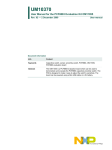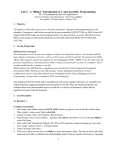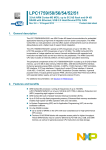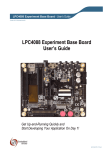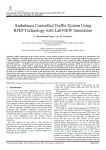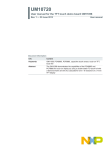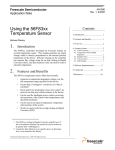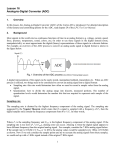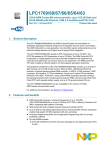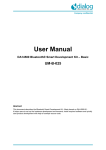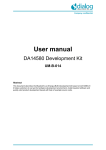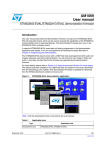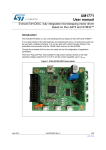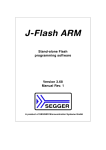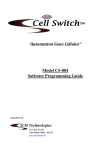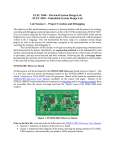Download AN11095 - Element14
Transcript
AN11095 Capacitive touch sensing using the LPC176x/5x Rev. 1 — 1 August 2011 Application note Document information Info Content Keywords LPC176x/5x, LPC1759FBD80, LPC1758FBD80, LPC1756FBD80, LPC1754FBD80, LPC1752FBD80, LPC1751FBD80, LPC1769FBD100, LPC1768FBD100, LPC1768FET100, LPC1767FBD100, LPC1766FBD100, LPC1765FBD100, LPC1764FBD100, LPC1763FBD100, Cortex M3, capacitive touch Abstract This application note describes the principle of using the LPC176x/5x series of microcontrollers from NXP Semiconductors for capacitive touch sensing AN11095 NXP Semiconductors Capacitive touch sensing using the LPC176x/5x Revision history Rev Date Description 1 Initial version. 20110801 Contact information For more information, please visit: http://www.nxp.com For sales office addresses, please send an email to: [email protected] AN11095 Application note All information provided in this document is subject to legal disclaimers. Rev. 1 — 1 August 2011 © NXP B.V. 2011. All rights reserved. 2 of 10 AN11095 NXP Semiconductors Capacitive touch sensing using the LPC176x/5x 1. Introduction This application note describes a simple capacitive touch sensing method using the ADC input of the LPC176x/5x microcontroller. The capacitive touch sensors used in this application note are areas of copper on the PCB of a PCF8883 evaluation board (see Fig 1). One of four available sensors is tied to an RC network and connected to an ADC input channel of the micro (see Fig 2). Fig 1. Sensors on the PCF evaluation board 2. Application principle Sensing of the capacitive touch pin can be done on each of the ADC input pins, and every pin can be configured as well for a general purpose output function. The sampling process (see Fig 2) is performed as follows: 1. Each I/O pin is configured as an output and driven high. This is used to charge the external RC network and the capacitive plate selected on the TCF evaluation board. When a measurement needs to be taken, the pin function is switched to the ADC input mode. Additionally, the pin drive strength is set to ‘float’, thus removing the internal pull resistor This causes the external capacitances to discharge via the external load resistance provided on the board, with a discharge curve which will depend on the capacitance and resistance values assembled on the board, and the parasitic capacitances related to the board itself. For example, the PCF evaluation board has a 5 k / 50 k resistor partition and a 10 pF capacitance assembled by default. When one of the capacitive plates gets touched, the total capacitance will include the body capacitance and increase in value, thereby increasing the time constant associated with the RC network discharge process. AN11095 Application note All information provided in this document is subject to legal disclaimers. Rev. 1 — 1 August 2011 © NXP B.V. 2011. All rights reserved. 3 of 10 AN11095 NXP Semiconductors Capacitive touch sensing using the LPC176x/5x In this way it is possible to compare the voltage reading being performed with a threshold value, in order to detect the button being pressed by the user in the two cases. 2. Sample the discharge curve. This is done by starting the ADC and reading out the converted value. The sample and hold function is performed in one ADC clock, and after 65 ADC clocks the ADC measurement is available in the relative data channel register AD0DRn. The end of conversion is signaled by the DONE bit being set in the ADC status register ADSTAT. 3. Finally, the I/O pin is configured back again as a ‘high’ output (back to first step) and the pull up resistor is switched on again. Fig 2. AN11095 Application note Waveform on ADC sensing pin All information provided in this document is subject to legal disclaimers. Rev. 1 — 1 August 2011 © NXP B.V. 2011. All rights reserved. 4 of 10 AN11095 NXP Semiconductors Capacitive touch sensing using the LPC176x/5x 3. Hardware configuration The hardware required for the test is an LPCXpresso 1768 stick and a PCF8883 evaluation kit (for the sensors). The following pins are used on the LPCXpresso stick: Table 1. Signal Hardware connection list Port Connector Uart_TxD3 P0.0 J6, pin 9 AD0.0, GPIO_0.23 P0.23 J6, pin 15 AD0.1, GPIO_0.24 P0.24 J6, pin 16 AD0.2, GPIO_0.25 P0.25 J6, pin 17 AD0.3, GPIO_0.26 P0.26 J6, pin 18 AD0.4, GPIO_1.30 P1.30 J6, pin 19 AD0.5, GPIO_1.31 P1.31 J6, pin 20 AD0.6, GPIO_0.2 P0.2 J6, pin 21 AD0.7, GPIO_0.3 P0.3 J6, pin 22 GND J6, pin 54 Connect any AD0.n port to the signal pad of connector RU1 and the GND pin to the ground pad of connector CU1 (refer to the PCF8883 evaluation board schematics and Fig 4). Diagram in Fig 3 shows ADC channel 2 and channel 3 being connected. Fig 3. Hardware connection diagram Note: For simultaneous testing of multiple channels, multiple PCF evaluation boards are required since only one type of sensor can be selected at one time on the PCF boards. AN11095 Application note All information provided in this document is subject to legal disclaimers. Rev. 1 — 1 August 2011 © NXP B.V. 2011. All rights reserved. 5 of 10 AN11095 NXP Semiconductors Capacitive touch sensing using the LPC176x/5x Note: CF pad connection for GND side was chosen for convenience, RC pad pin could be used as well Fig 4. Schematic details for hardware connection The default sensor plate selected on the PCF evaluation board is CP1. The other sensors can be chosen by using Jumper J5, although this would require a small hardware modification (cutting a board trace as documented in the PCF evaluation board user manual). 4. Demo code description The LPC176x/5x example code follows the same principle as described in AN11023 for the Cortex-M0 platform, although there are a few differences and enhancements introduced. The demo software is able to handle multiple channels, and can be configured to use all of the available ADC channels on the LPC17xx device. In the file config.h the user can specify a mapping between a logic keypad number and the associated ADC channel number. Additionally, the user can specify if a specific keypad (numbered from 1 to 8) is used or not. This is used at compile time to reduce the size of the code in case the keypad is not used. There is a table of callback functions, which are defined in files callbacks.h, callbacks.c and are related to the functions which are called by the application whenever a key press is detected. A calibration loop is run at startup which performs a number of successive readings on each channel, calculates a reference mean value, and stores this for later use in order to calculate the detection thresholds. After the calibration loop is finished, the CPU goes to sleep by issuing a “wait for interrupt” instruction, waiting for the post-processing to be performed. AN11095 Application note All information provided in this document is subject to legal disclaimers. Rev. 1 — 1 August 2011 © NXP B.V. 2011. All rights reserved. 6 of 10 AN11095 NXP Semiconductors Capacitive touch sensing using the LPC176x/5x The sampling of the channels is done periodically, being triggered by the Systick timer every 10 msec. This periodic event could be generated via any other timer, though. Systick was chosen since only this periodic timing functionality is really required. When the Systick interrupt is triggered, the configured ADC channels (the channels which are defined as being used, thus linked to a “logical” keypad number) get sampled one after the other by triggering the ADC channel conversion in software. The ADC clock was chosen as close as possible to its top supported speed of 13 MHz, for reducing the latency when performing the conversion. When the Systick interrupt routine has finished looping over all active ADC channels, at the end of the Systick handler, a GPIO pin is used to toggle the led on the LPCXpresso stick, to provide a “heartbeat” signal. The interrupt handler is then exited. At this time, the CPU is woken up from sleep and starts processing the readings by calling the function processKeystrokes(). The default rule being chosen for the detection of a sensor being touched requires the current ADC reading to be above 8 % of the average. A total of M consecutive detections (default of 8) being performed in a row define a key press event. This is used to implement debounce functionality, and can be changed as desired and appropriate. When it is detected that a key has been pressed, the associated callback function is run. The default example callbacks are all outputting a debug string on the UART3 interface, which includes a progressive counter, the keypad number pressed, the last ADC reading and the average (threshold) value for that channel. The UART configuration is very simple, set at 115200 bps, 8 bit, 1 stop bit. Neither parity check nor control flow are used. The software example is written in C language and compiled using Keil’s uVision (MDKARM, V4.20). For LPC176x/5x microcontroller configuration the standard CMSIS startup modules (startup_LPC176x/5x.s and system_LPC176x/5x.c) from Keil were used. The system clock used is the IRC, and the CPU is configured to run at 100 MHz via the internal PLL. The demo software was tested on the LPCXpresso stick assembled with a LPC1768 device. 4.1 Implementation details The actual demo code determines the compare thresholds at the beginning of the application, but does not update the threshold values during the application’s lifetime. For a more sophisticated behavior, it might be desirable to adapt the thresholds at runtime, to take into account possible changes in the environment which can have an influence on the sensor’s behavior (temperature, aging, dirt etc), if the system is staying powered for long periods without being restarted. Also, some filtering might be introduced to reduce other effects like interference and noise on the readings. The user might also choose, e.g., another timer to trigger slower periodic updates of the threshold, or to perform a full periodic calibration (instead of just a start-up calibration), or to change the thresholds dynamically during the processing of the readings. However, all of this is highly application and system dependent, so the demo application does not cover such scenarios. Additionally, more advanced strategies might be used to determine the most effective thresholds and algorithms to determine a key press event. This would depend as well AN11095 Application note All information provided in this document is subject to legal disclaimers. Rev. 1 — 1 August 2011 © NXP B.V. 2011. All rights reserved. 7 of 10 AN11095 NXP Semiconductors Capacitive touch sensing using the LPC176x/5x from the board layout and the RC characteristic of each load connected to the ADC pins. The demo code is just using a simple static threshold level for the detection process. The processing done within the Systick interrupt routine is kept to a minimum, and the processing of the ADC readings is delegated to the application layer. This is in order to keep the IRQ latency to the minimum possible, improving the system response. In case other system or peripheral interrupts might be active, and preempt the Systick interrupt, the user will have to ensure that the sampling steps 2 and 3 are not being disrupted. This means the higher priority interrupts will need to be masked, to preserve the timing relationship between the switching of the IO pin to ADC mode, and the ADC trigger point on the discharge curve. 5. References For further details please refer to the following publications: Datasheets / User Manuals / Application Notes / Example code: http://nxp.com/microcontrollers/ AN10832: “PCF8883 - capacitive proximity switch with auto-calibration”: http://www.nxp.com/documents/application_note/AN10832.pdf UM10370: “User Manual for the PCF8883 Evaluation Kit OM11055”: http://www.nxp.com/documents/user_manual/UM10370.pdf AN11023: “Capacitive touch sensing using the LPC11xx”: http://www.nxp.com/documents/application_note/AN11023.pdf AN11095 Application note All information provided in this document is subject to legal disclaimers. Rev. 1 — 1 August 2011 © NXP B.V. 2011. All rights reserved. 8 of 10 AN11095 NXP Semiconductors Capacitive touch sensing using the LPC176x/5x 6. Legal information provide appropriate design and operating safeguards to minimize the risks associated with their applications and products. 6.1 Definitions Draft — The document is a draft version only. The content is still under internal review and subject to formal approval, which may result in modifications or additions. NXP Semiconductors does not give any representations or warranties as to the accuracy or completeness of information included herein and shall have no liability for the consequences of use of such information. 6.2 Disclaimers Limited warranty and liability — Information in this document is believed to be accurate and reliable. However, NXP Semiconductors does not give any representations or warranties, expressed or implied, as to the accuracy or completeness of such information and shall have no liability for the consequences of use of such information. In no event shall NXP Semiconductors be liable for any indirect, incidental, punitive, special or consequential damages (including - without limitation lost profits, lost savings, business interruption, costs related to the removal or replacement of any products or rework charges) whether or not such damages are based on tort (including negligence), warranty, breach of contract or any other legal theory. Notwithstanding any damages that customer might incur for any reason whatsoever, NXP Semiconductors’ aggregate and cumulative liability towards customer for the products described herein shall be limited in accordance with the Terms and conditions of commercial sale of NXP Semiconductors. Right to make changes — NXP Semiconductors reserves the right to make changes to information published in this document, including without limitation specifications and product descriptions, at any time and without notice. This document supersedes and replaces all information supplied prior to the publication hereof. Suitability for use — NXP Semiconductors products are not designed, authorized or warranted to be suitable for use in life support, life-critical or safety-critical systems or equipment, nor in applications where failure or malfunction of an NXP Semiconductors product can reasonably be expected to result in personal injury, death or severe property or environmental damage. NXP Semiconductors accepts no liability for inclusion and/or use of NXP Semiconductors products in such equipment or applications and therefore such inclusion and/or use is at the customer’s own risk. Applications — Applications that are described herein for any of these products are for illustrative purposes only. NXP Semiconductors makes no representation or warranty that such applications will be suitable for the specified use without further testing or modification. NXP Semiconductors does not accept any liability related to any default, damage, costs or problem which is based on any weakness or default in the customer’s applications or products, or the application or use by customer’s third party customer(s). Customer is responsible for doing all necessary testing for the customer’s applications and products using NXP Semiconductors products in order to avoid a default of the applications and the products or of the application or use by customer’s third party customer(s). NXP does not accept any liability in this respect. Export control — This document as well as the item(s) described herein may be subject to export control regulations. Export might require a prior authorization from national authorities. Evaluation products — This product is provided on an “as is” and “with all faults” basis for evaluation purposes only. NXP Semiconductors, its affiliates and their suppliers expressly disclaim all warranties, whether express, implied or statutory, including but not limited to the implied warranties of noninfringement, merchantability and fitness for a particular purpose. The entire risk as to the quality, or arising out of the use or performance, of this product remains with customer. In no event shall NXP Semiconductors, its affiliates or their suppliers be liable to customer for any special, indirect, consequential, punitive or incidental damages (including without limitation damages for loss of business, business interruption, loss of use, loss of data or information, and the like) arising out the use of or inability to use the product, whether or not based on tort (including negligence), strict liability, breach of contract, breach of warranty or any other theory, even if advised of the possibility of such damages. Notwithstanding any damages that customer might incur for any reason whatsoever (including without limitation, all damages referenced above and all direct or general damages), the entire liability of NXP Semiconductors, its affiliates and their suppliers and customer’s exclusive remedy for all of the foregoing shall be limited to actual damages incurred by customer based on reasonable reliance up to the greater of the amount actually paid by customer for the product or five dollars (US$5.00). The foregoing limitations, exclusions and disclaimers shall apply to the maximum extent permitted by applicable law, even if any remedy fails of its essential purpose. 6.3 Trademarks Notice: All referenced brands, product names, service names and trademarks are property of their respective owners. Customers are responsible for the design and operation of their applications and products using NXP Semiconductors products, and NXP Semiconductors accepts no liability for any assistance with applications or customer product design. It is customer’s sole responsibility to determine whether the NXP Semiconductors product is suitable and fit for the customer’s applications and products planned, as well as for the planned application and use of customer’s third party customer(s). Customers should AN11095 Application note All information provided in this document is subject to legal disclaimers. Rev. 1 — 1 August 2011 © NXP B.V. 2011. All rights reserved. 9 of 10 AN11095 NXP Semiconductors Capacitive touch sensing using the LPC176x/5x 7. Contents 1. 2. 3. 4. 4.1 5. 6. 6.1 6.2 6.3 7. Introduction .........................................................3 Application principle...........................................3 Hardware configuration ......................................5 Demo code description.......................................6 Implementation details .......................................7 References ...........................................................8 Legal information ................................................9 Definitions ..........................................................9 Disclaimers.........................................................9 Trademarks ........................................................9 Contents.............................................................10 Please be aware that important notices concerning this document and the product(s) described herein, have been included in the section 'Legal information'. © NXP B.V. 2011. All rights reserved. For more information, please visit: http://www.nxp.com For sales office addresses, please send an email to: [email protected] Date of release: 1 August 2011 Document identifier: AN11095












